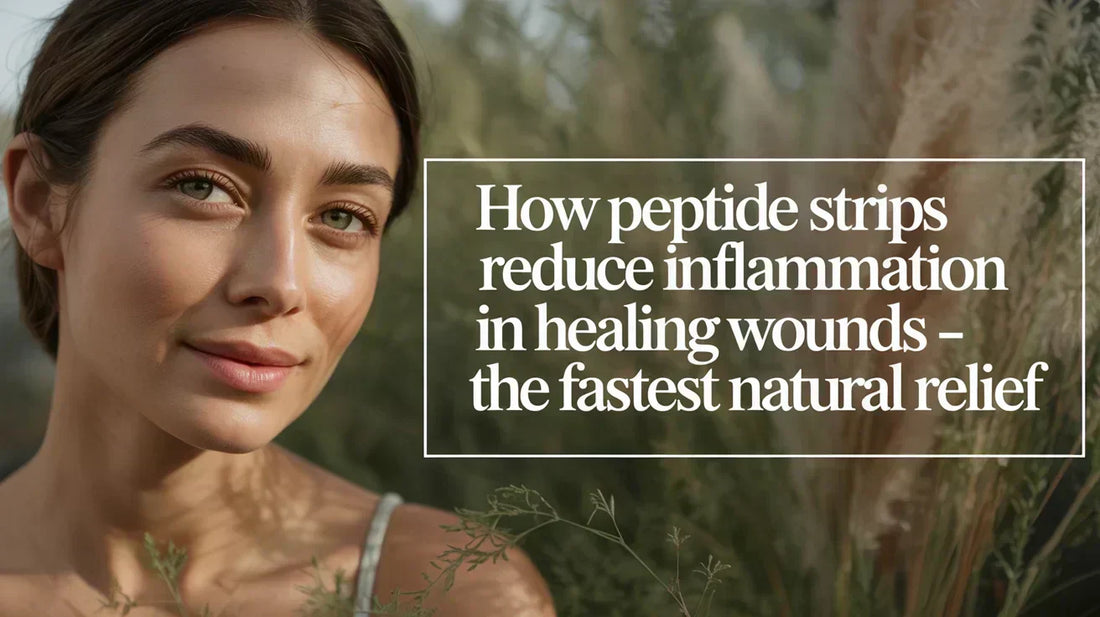
How Peptide Strips Reduce Inflammation in Healing Wounds - The Fastest Natural Relief
Share
Peptide strips can dramatically reduce inflammation in healing wounds by supporting the body’s natural repair processes. These dissolvable oral strips deliver bioactive peptides like BPC-157 and TB-500 through the mucosal tissues directly into the bloodstream, helping to control inflammation systemically without harsh side effects.
If you’re dealing with wounds that seem to stay red, swollen, or painful longer than expected, peptide therapy strips may offer the relief you’re looking for, naturally and effectively.
Why Inflammation Slows Down Wound Healing
Inflammation is a necessary phase of wound healing, but prolonged or uncontrolled inflammation can delay recovery and increase scarring. It can be triggered by infection, repeated trauma, or an overactive immune response.
Effects of Chronic Inflammation on Wounds
When inflammation lingers too long, it can lead to:
- Delayed cell migration and tissue regeneration
- Higher risk of infection and fluid buildup
- Excess collagen production that leads to scarring
How Peptide Strips Work to Control Inflammation
Oral peptide strips work systemically to modulate the body’s inflammatory response from the inside out.
Anti-Inflammatory Mechanisms of Key Peptides
Peptides like BPC-157 and TB-500 have shown strong anti-inflammatory effects in clinical and lab studies:
- BPC-157: Inhibits pro-inflammatory cytokines such as TNF-alpha and IL-6 while boosting vascular growth for improved healing.
- TB-500: Regulates immune response and increases T-cell production, promoting balanced inflammation control.
These peptides target the root of inflammation rather than just masking symptoms.
Benefits of Reducing Inflammation During Healing
Controlling inflammation doesn’t just ease pain, it accelerates overall wound recovery and improves skin regeneration.

Key Benefits Users Experience
- Reduced swelling and redness within 1–3 days
- Decreased pain and discomfort during the healing process
- Improved blood flow and oxygen delivery to the injury site
- Faster closure and epithelialization of open wounds
Best Timing and Dosage to Reduce Inflammation with Peptide Strips
To get the most anti-inflammatory effects, users need to time their peptide therapy appropriately.
When to Start Peptide Strips for Inflammation Relief
- Start within 24–48 hours of injury to catch the peak of the inflammatory response
- Continue through the proliferative phase (up to 10–14 days) for sustained support
Dosage Guidelines
- Mild inflammation: 1 strip daily
- Moderate to severe inflammation: 2 strips daily (AM and PM)
- Always consult with a healthcare professional if inflammation persists or worsens
Signs Peptide Strips Are Working for Inflammation
Visible changes are the best way to know your peptide therapy is helping.
Early Indicators of Positive Response
- Reduction in heat and redness around the wound site
- Softening of surrounding tissues, less stiffness
- Lower need for NSAIDs or pain relievers
Supporting Anti-Inflammatory Effects with Lifestyle Choices
Peptide therapy is most effective when paired with habits that promote reduced inflammation systemically.
Lifestyle Strategies That Help
- Anti-inflammatory diet: Include turmeric, ginger, leafy greens, and omega-3 fatty acids
- Hydration: Keeps tissues flexible and improves nutrient delivery
- Quality sleep: Encourages proper immune response and tissue repair
- Avoid smoking or alcohol: Both interfere with inflammatory and healing responses
Complementary Treatments to Enhance Results
You can pair peptide strips with other natural or conventional anti-inflammatory options for a holistic approach.
Safe Additions to Peptide Therapy
- Topical anti-inflammatories: Such as aloe vera or calendula for surface-level calming
- Physical rest: Avoiding repetitive pressure or motion that irritates healing tissue
- Cold therapy: For the first 48 hours, ice can help while peptides work internally
FAQs About How Peptide Strips Reduce Inflammation in Healing Wounds
Here are some questions and answers about using peptide therapy oral strips to reduce inflammation during wound healing:
Do peptide strips reduce inflammation or just speed up healing?
Both. Peptides like BPC-157 and TB-500 have direct anti-inflammatory effects and also stimulate tissue regeneration, which shortens the healing cycle.
How fast do inflammation symptoms improve?
Most users see noticeable relief from swelling and pain within 2–4 days of consistent use.
Can I use peptide strips alongside ibuprofen?
Yes, but with caution. Peptides work at the cellular level and may reduce your reliance on NSAIDs. Always consult a physician before combining treatments long-term.
Are there any side effects from reducing inflammation too quickly?
No major side effects are reported. These peptides regulate inflammation naturally and don’t suppress immune response the way steroids do.
Is peptide therapy effective for all types of inflammation?
It’s most effective for wound-related and soft tissue inflammation. For systemic or autoimmune-related inflammation, a more targeted approach may be needed with medical supervision.
If inflammation is slowing your wound healing, oral peptide strips may offer a natural, science-supported solution to get your recovery back on track. By controlling excessive swelling and promoting balanced immune function, they provide both short-term relief and long-term healing benefits.
